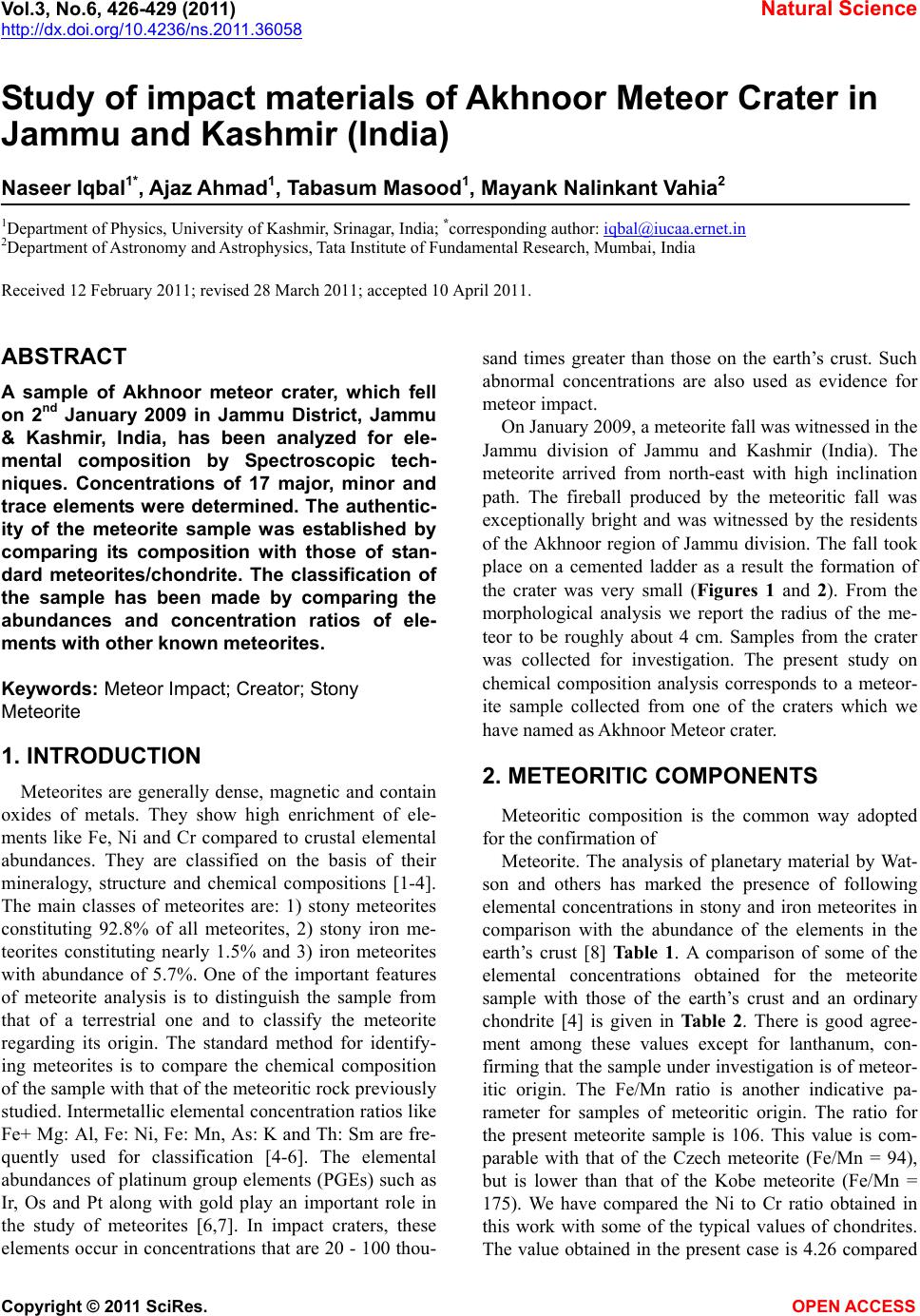
Vol.3, No.6, 426-429 (2011) Natural Science
http://dx.doi.org/10.4236/ns.2011.36058
Copyright © 2011 SciRes. OPEN ACCESS
Study of impact materials of Akhnoor Meteor Crater in
Jammu and Kashmir (India)
Naseer Iqbal1*, Ajaz Ahmad1, Tabasum Masood1, Mayank Nalinkant Vahia2
1Department of Physics, University of Kashmir, Srinagar, India; *corresponding author: iqbal@iucaa.ernet.in
2Department of Astronomy and Astrophysics, Tata Institute of Fundamental Research, Mumbai, India
Received 12 February 2011; revised 28 March 2011; accepted 10 April 2011.
ABSTRACT
A sample of Akhnoor meteor crater, which fell
on 2nd January 2009 in Jammu District, Jammu
& Kashmir, India, has been analyzed for ele-
mental composition by Spectroscopic tech-
niques. Concentrations of 17 major, minor and
trace elements were determined. The authentic-
ity of the meteorite sample was established by
comparing its composition with those of stan-
dard meteorites/chondrite. The classification of
the sample has been made by comparing the
abundances and concentration ratios of ele-
ments with other known meteorites.
Keywords: Meteor Impact; Creator; Stony
Meteorite
1. INTRODUCTION
Meteorites are generally dense, magnetic and contain
oxides of metals. They show high enrichment of ele-
ments like Fe, Ni and Cr compared to crustal elemental
abundances. They are classified on the basis of their
mineralogy, structure and chemical compositions [1-4].
The main classes of meteorites are: 1) stony meteorites
constituting 92.8% of all meteorites, 2) stony iron me-
teorites constituting nearly 1.5% and 3) iron meteorites
with abundance of 5.7%. One of the important features
of meteorite analysis is to distinguish the sample from
that of a terrestrial one and to classify the meteorite
regarding its origin. The standard method for identify-
ing meteorites is to compare the chemical composition
of the sample with that of the meteoritic rock previously
studied. Intermetallic elemental concentration ratios like
Fe+ Mg: Al, Fe: Ni, Fe: Mn, As: K and Th: Sm are fre-
quently used for classification [4-6]. The elemental
abundances of platinum group elements (PGEs) such as
Ir, Os and Pt along with gold play an important role in
the study of meteorites [6,7]. In impact craters, these
elements occur in concentrations that are 20 - 100 thou-
sand times greater than those on the earth’s crust. Such
abnormal concentrations are also used as evidence for
meteor impact.
On January 2009, a meteorite fall was witnessed in the
Jammu division of Jammu and Kashmir (India). The
meteorite arrived from north-east with high inclination
path. The fireball produced by the meteoritic fall was
exceptionally bright and was witnessed by the residents
of the Akhnoor region of Jammu division. The fall took
place on a cemented ladder as a result the formation of
the crater was very small (Figures 1 and 2). From the
morphological analysis we report the radius of the me-
teor to be roughly about 4 cm. Samples from the crater
was collected for investigation. The present study on
chemical composition analysis corresponds to a meteor-
ite sample collected from one of the craters which we
have named as Akhnoor Meteor crater.
2. METEORITIC COMPONENTS
Meteoritic composition is the common way adopted
for the confirmation of
Meteorite. The analysis of planetary material by Wat-
son and others has marked the presence of following
elemental concentrations in stony and iron meteorites in
comparison with the abundance of the elements in the
earth’s crust [8] Table 1. A comparison of some of the
elemental concentrations obtained for the meteorite
sample with those of the earth’s crust and an ordinary
chondrite [4] is given in Table 2. There is good agree-
ment among these values except for lanthanum, con-
firming that the sample under investigation is of meteor-
itic origin. The Fe/Mn ratio is another indicative pa-
rameter for samples of meteoritic origin. The ratio for
the present meteorite sample is 106. This value is com-
parable with that of the Czech meteorite (Fe/Mn = 94),
but is lower than that of the Kobe meteorite (Fe/Mn =
175). We have compared the Ni to Cr ratio obtained in
this work with some of the typical values of chondrites.
The value obtained in the present case is 4.26 compared